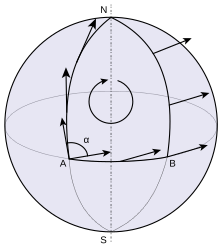
In differential geometry, parallel transport (or parallel translation[a]) is a way of transporting geometrical data along smooth curves in a manifold. If the manifold is equipped with an affine connection (a covariant derivative or connection on the tangent bundle), then this connection allows one to transport vectors of the manifold along curves so that they stay parallel with respect to the connection.
The parallel transport for a connection thus supplies a way of, in some sense, moving the local geometry of a manifold along a curve: that is, of connecting the geometries of nearby points. There may be many notions of parallel transport available, but a specification of one way of connecting up the geometries of points on a curve is tantamount to providing a connection. In fact, the usual notion of connection is the infinitesimal analog of parallel transport. Or, vice versa, parallel transport is the local realization of a connection.
As parallel transport supplies a local realization of the connection, it also supplies a local realization of the curvature known as holonomy. The Ambrose–Singer theorem makes explicit this relationship between the curvature and holonomy.
Other notions of connection come equipped with their own parallel transportation systems as well. For instance, a Koszul connection in a vector bundle also allows for the parallel transport of vectors in much the same way as with a covariant derivative. An Ehresmann or Cartan connection supplies a lifting of curves from the manifold to the total space of a principal bundle. Such curve lifting may sometimes be thought of as the parallel transport of reference frames.
- ^ Spivak 1999, p. 234, Vol. 2, Ch. 6.
Cite error: There are <ref group=lower-alpha> tags or {{efn}} templates on this page, but the references will not show without a {{reflist|group=lower-alpha}} template or {{notelist}} template (see the help page).
